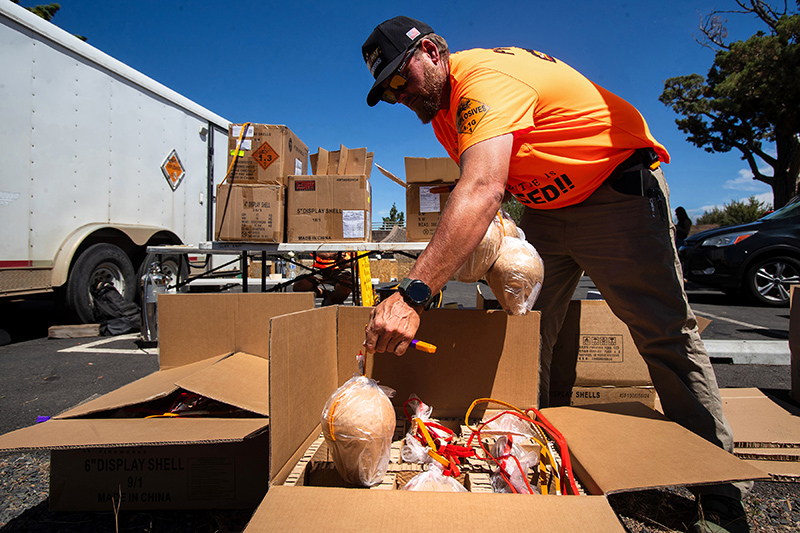Summer Lake offers refuge for threatened swans
Published 12:00 am Friday, April 27, 2018

- Two trumpeter swans swim together on a marsh in the Summer Lake Wildlife Area after being released Tuesday. The swans were transported to the wildlife area from the Sunriver Nature Center. (Kyle Spurr/Bulletin photo)
SUMMER LAKE — A vast wildlife refuge and hunting area tucked against snow-capped hills is home to hundreds of waterfowl.
The Summer Lake Wildlife Area, 19,000 acres of wetlands overseen by the Oregon Department of Fish and Wildlife, is an ideal habitat for the various waterbirds. The area in central Lake County is covered in marshes and lakes that attract cranes, geese and 12 species of ducks.
It is also a critical site for trumpeter swans, a protected species slowly recovering after being hunted to near-extinction in the early 1900s, when none remained in Oregon. Through a state program to re-establish them, 112 swans have been released at Summer Lake since 2009.
On Tuesday, their numbers increased by two.
Gary Ivey, 66, of Bend, past president of the Trumpeter Swan Society and former biologist at Malheur National Wildlife Refuge, transported two young swans, or cygnets. They had been kept at the Sunriver Nature Center since hatching last summer.
Ivey put the swans in dog carriers for the drive down to Summer Lake, where he met Marty St. Louis, 62, manager of the Summer Lake Wildlife Area. Together, they released the swans on the shore of a marsh. The birds glided together across the water, starting a new life in the wild.
“Now, just stay alive,” Ivey said as he watched them.
Ivey’s concern is warranted. For the past three decades, Ivey has worked to successfully reintroduce the swan population in Oregon as a member of the Trumpeter Swan Society, a national conservation organization dedicated to growing wild swan populations.
But almost every step forward follows two steps back, he said.
Even under the best of circumstances, half of all young swans die before reaching the breeding age of 4, he said. Young swans are vulnerable to predators, such as coyotes and bobcats.
The challenge is getting the other half to the breeding age. Many of the swans released at Summer Lake come from captivity in zoos or the Wyoming Wetland Society, which breeds and supplies swans to wildlife areas around the Western United States. Captive swans have trouble in the wild. They are often killed flying into power poles and are more likely to be eaten by predators.
Oregon has about 35 wild trumpeter swans with about 15 to 20 spending most of their time at Summer Lake. The goal of the state reintroduction program is 15 pairs of breeding wild swans. It’s an ambitious goal since only two breeding pairs were seen last summer. But 15 pairs would give the population a chance to be self-sufficient without needing to release captive swans, Ivey said.
“It’s a numbers game, and unfortunately, you have to get to a certain threshold with enough wild birds,” Ivey said. “These wild birds are a great hope for the future because they are totally reared by parents in the wild, and they can be a lot more savvy than ones that were fed by people.”
In recent years, the repopulation goal has hit major setbacks when hunters illegally killed swans.
The swans released Tuesday are two of four offspring fathered by Chuck, an 11-year-old swan who was a beloved fixture at the Sunriver Nature Center. Chuck and his mate, Gracie, produced multiple offspring over the years and were considered an important piece to the repopulation effort.
But on Thanksgiving Day, Chuck was shot and killed on the Deschutes River just northwest of Sunriver. The accused shooter, Jordan A. Dupuis, 23, of Bend, has been charged with a wildlife violation for killing a threatened species.
In October 2016, a hunter shot two swans at Summer Lake. One of them was Fiona, another offspring of Chuck and Gracie, that had only been there a few months. The other swan, Hope, who later died in surgery, was the first cygnet hatched in the wild at Summer Lake to reach adulthood. The hunter, Michael J. Abbott, 35, of Cottage Grove, was ordered to pay $4,750 in restitution and serve one year probation, and he lost his hunting license for three years.
Among all of the ways swans die, being shot and killed by hunters is the most frustrating for wildlife officials, who felt the loss of Hope deeply. Hope was close to breeding age.
“All of a sudden, we are back to square one,” Ivey said.
That hard truth keeps Ivey at Summer Lake, introducing swans into the wild. The area offers an environment that is so nurturing, roughly 240 swans spent time there in this winter. The two swans released Tuesday will be joined next week by their two siblings, which are still at Sunriver.
Trumpeter swans are impressive birds. Their wingspan can reach 7 feet, and they can weigh up to 30 pounds, the largest native waterfowl in North America. They can live to be 30. A close look at a swan reveals three sharp claws on each of their webbed feet and a large wrist bone on their wings that they can use to punch when threatened.
The two young swans, each weighing about 20 pounds, were not pleased Tuesday sitting cramped in dog carriers. Each swan let out a loud hissing noise, which didn’t rattle Ivey.
“Birds and reptiles are closely related. That is why they sound like snakes,” Ivey said. “They have these long snake necks.”
Ivey took the dog carriers out of his pickup and set them inside a workshop at the Summer Lake Wildlife Area, where St. Louis placed neck and leg tags on the birds and took blood samples to confirm their gender. Results of the blood samples may be ready next week.
St. Louis, recognizable in the small town of Summer Lake by his signature fu manchu mustache, has lived and worked in the community of under 100 people for the past 31 years. He lives with his two dogs in a house on the wildlife area that is provided by the state fish and wildlife service.
“This goes beyond being a job,” St. Louis said. “It’s more of a lifestyle.”
After the blood draw, St. Louis carefully placed bands on the two swans. Their green neck bands identified the birds. One read “6@6” and the other read “6@7.” That’s what St. Louis prefers to call the swans. He dislikes human names.
“It’s Walt Disney-ish,” he said “We want these to be wild birds.”
St. Louis and Ivey loaded the two banded birds into a white ODFW pickup with a camouflage interior and they rode out to one of three designated refuges in the wildlife area called Bullgate Refuge.
St. Louis opened the dog carriers at the Bullgate Refuge. He and Ivey watched as the two swans entered their natural habitat.
After the release, St. Louis and Ivey rode along a dike to another marsh where about eight trumpeter swans were swimming. They hoped the two new swans would find the group and learn how to survive in the wild.
On the ride back to his workshop, St. Louis looked out the window of his pickup. He spotted the two swans out of the corner of his eye.
“Good,” he said. “They are still alive.”
— Reporter: 541-617-7820, kspurr@bendbulletin.com








